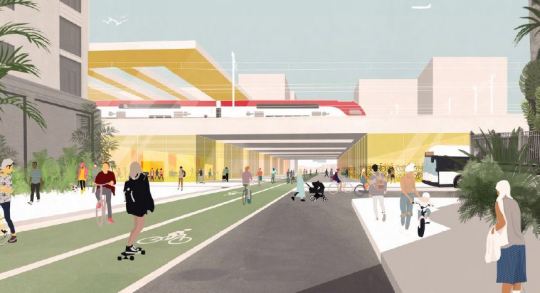Last year when San Francisco state Sen. Scott Wiener introduced SB 827, his proposal sparked a red-hot debate over how and where we build housing in the Golden State. The measure would have required cities to allow housing developments of four to eight stories within a half-mile radius of every BART station, Caltrain stop or other railroad station, and a quarter-mile from bus stops where buses run every 15 minutes during commute times.
Pro-development groups who believe the state should relinquish its attachment to single-family homes cheered. City officials weary of state-led influence over local developments gulped... Social justice and affordable housing advocacy groups balked, decrying the measure as a give-away to developers at the expense of low-income and working class residents who would be displaced if the bill had passed.
The bill was dead on arrival — even before the formal debate in the legislature over its merits and flaws could begin.
ashby BART station in berkeley. the surface car parking lot could be transformed into housing and other uses. photo: jane tyska.
This time, Wiener says he took a different tack. He reached out to critics of the original measure, he said, and tried to include their feedback in the latest version of the bill, now called More H.O.M.E.S. (Housing, Opportunity, Mobility, Equity, and Stability). The new version, SB 50, was introduced Monday.
It’s already raising alarm bells, said Palo Alto Mayor Liz Kniss, whose City Council drafted a letter opposing the original measure. That’s because one of the key changes was including “jobs-rich” project areas in the proposal, which means cities and towns that have done a good job at attracting employers and bringing jobs to the area, but haven’t built enough housing, wouldn’t be able to reject housing projects based on certain height and density limits — even if the projects aren’t near high-frequency transit.
“It’s interesting and potentially alarming,” Kniss said. “It could have an enormous impact.”
Like its predecessor, the More H.O.M.E.S. Act does not change local rules governing affordable housing policies, design review or demolition of historic buildings. But it now requires developers to provide affordable housing as long as the local jurisdiction doesn’t already have rules in place requiring that. It also prohibits the demolition of existing rental units and gives low-income communities more time to implement the bill, Wiener said.
The new bill lowers height requirements a little so the tallest buildings near rail stations would be five stories, not eight. For housing near bus routes, cities can keep existing height restrictions in place but can’t limit density. That means cities can’t reject a story-two apartment building if the land is zoned for single-family homes, Wiener said.
“The heart of the bill is still the same,” he said. “There are some changes to address displacement concerns and also to make sure we are focusing on both areas near public transit, as well as job-rich areas.”
to Palo Alto Mayor Liz Kniss: this is “potentially alarming” because your city failed at providing a good balance of jobs and housing?? palo alto allowed offices but restricted housing growth—screwing up traffic with people unable to live near where they work, so they have to drive from farther away—your city messed up and now you’re scared to fix it???!












